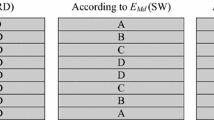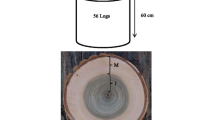Abstract
The first objective of this work was to study the influence of veneer quality on the mechanical properties of laminated veneer lumber (LVL) made of secondary quality hardwood. The second objective was to propose an adapted veneer thickness that provides the optimum mechanical properties of LVL, taking the veneer properties into account. Forty-eight LVL panels glued together using polyvinyl acetate (PVAc) were prepared. The quality of fresh veneers was assessed by measuring veneer knot proportion, lathe check depth and lathe check interval. The static modulus of elasticity (MOE), dynamic MOE, modulus of rupture (MOR) and shear modulus were measured using destructive and non-destructive methods. The 3 mm thick veneer provided the optimum mechanical properties for LVL for both species. The test direction did not have any significant influence on the mechanical properties. In the flatwise direction, the average MOE values obtained were 13.2 GPa for beech LVL and 13.3 GPa for oak LVL, whereas the MOR was 72.0 MPa and 63.4 MPa, respectively. Increasing knot proportion in veneers results in a decrease in LVL MOE and MOR. Moreover, deeper lathe checks and higher lathe check intervals on veneer surfaces provide lower LVL shear modulus in the edgewise direction for both species. Internal veneer provides LVL with a higher density but weaker mechanical properties due to a higher knot proportion in the internal veneer.




Similar content being viewed by others

References
Aydın İ, Çolak S, Çolakoğlu G, Salih E (2004) A comparative study on some physical and mechanical properties of Laminated Veneer Lumber (LVL) produced from Beech (Fagus orientalis) and Eucalyptus (Eucalyptus camaldulensis) veneers. Holz Roh Werkst 62:218–220. https://doi.org/10.1007/s00107-004-0464-3
Bendtsen B (1978) Properties of wood from improved and intensively managed trees. For Prod J 28:61–72
Brancheriau L, Bailleres H (2002) Natural vibration analysis of clear wooden beams: a theoretical review. Wood Sci Technol 36:347–365. https://doi.org/10.1007/s00226-002-0143-7
Brancheriau L, Paradis S, Baillères H (2007) Bing—beam identification by non-destructive grading (Cirad). https://doi.org/10.18167/62696E67. http://agritrop.cirad.fr/576230/. Accessed 20 July 2018
Burdurlu E, Kilic M, Ilce AC, Uzunkavak O (2007) The effects of ply organization and loading direction on bending strength and modulus of elasticity in laminated veneer lumber (LVL) obtained from beech (Fagus orientalis L.) and lombardy poplar (Populus nigra L.). Constr Build Mater 21:1720–1725. https://doi.org/10.1016/j.conbuildmat.2005.05.002
Daoui A, Descamps C, Marchal R, Zerizer A (2011) Influence of veneer quality on beech LVL mechanical properties. Maderas Cienc Tecnol 13:69–83. https://doi.org/10.4067/S0718-221X2011000100007
Denaud L, Bléron L, Ratle A, Marchal R (2007) Online control of wood peeling process: acoustical and vibratory measurements of lathe checks frequency. Ann For Sci 64:569–575. https://doi.org/10.1051/forest:2007034
Ebihara T (1981) Shear properties of laminated-veneer lumber (LVL). J Jpn Wood Res Soc 27:788–794
Eckelman CA (1993) Potential uses of laminated veneer lumber in furniture. For Prod J 43:19–24
Girardon S, Denaud L, Pot G, Rahayu I (2016) Modelling the effects of wood cambial age on the effective modulus of elasticity of poplar laminated veneer lumber. Ann For Sci 73:615–624. https://doi.org/10.1007/s13595-016-0569-y
Hoover WL, Ringe JM, Eckelman CA, Youngquist JA (1987) Material design factors for hardwood laminated-veneer-lumber. For Prod J USA 37:15–23
IGN (2016) La memento inventaire forestier: la foret en ciffre et en carte. In: Institut national de l’information géographique et forestière, Paris (The memento of the forest inventory: the forest in figures and maps). National Institute for geographical and forestry information, Paris (in French). https://inventaire-forestier.ign.fr/IMG/pdf/161122_memento2016-2.pdf
Kilic M, Hiziroglu S, Burdurlu E (2006) Effect of machining on surface roughness of wood. Build Environ 41:1074–1078. https://doi.org/10.1016/j.buildenv.2005.05.008
Knorz M, van de Kuilen J (2012) Development of a high-capacity engineered wood product—LVL made of European beech (Fagus sylvatica L.). In: Proceeding of the 12th world conference on timber engineering, Auckland, pp 487–495
Knudson RM, Wang BJ, Zhang SY (2007) Properties of veneer and veneer-based products from genetically improved white spruce plantations. Wood Fiber Sci 38:17–27
Kretschmann DE, Moody RC, Pellerin RF et al (1993) Effect of various proportions of juvenile wood on laminated veneer lumber. US Department of Agriculture, Forest Service, Forest Products Laboratory, Washington
Lam F (2001) Modern structural wood products. Prog Struct Eng Mater 3:238–245. https://doi.org/10.1002/pse.79
Marchall R (1995) Une alternative pour les bois feuillus de qualité secondaire: les LVL (laminated veneer lumber), lamelles-colles de placages. (An alternative for secondary quality hardwoods: LVL (laminated veneer lumber), glued laminated veneer) (in French). Rev For Fr 47:375–382
McGavin RL, Bailleres H, Hamilton M, Blackburn D, Vega M, Ozarska B (2014) Variation in rotary veneer recovery from australian plantation Eucalyptus globulus and Eucalyptus nitens. BioResources 10:313–329. https://doi.org/10.15376/biores.10.1.313-329
McKeever DB (1997) Engineered wood products: a response to the changing timber resource. Pacific Rim Wood Market Report. https://www.fpl.fs.fed.us/documnts/pdf1997/mckee97b.pdf. Accessed 20 June 2018
Melo RR de, Menezzi CHSD (2014) Influence of veneer thickness on the properties of LVL from Paricá (Schizolobium amazonicum) plantation trees. Eur J Wood Prod 72:191–198. https://doi.org/10.1007/s00107-013-0770-8
Ministère de l’Agriculture et de l’Alimentation-Agreste (2017) Chiffres et Données Agriculture: Récolte de bois et production de sciages en 2016. Ministère de l’Agriculture et de l’Alimentation-Agreste, Paris (Agriculture Data and Figures: Timber Harvesting and Sawmill Production in 2016. The ministry of Agriculture and Food-Agreste, Paris) (in French)
Moore J, Achim A, Lyon A, Mochan S, Gardiner B (2009) Effects of early re-spacing on the physical and mechanical properties of Sitka spruce structural timber. For Ecol Manag 258:1174–1180. https://doi.org/10.1016/j.foreco.2009.06.009
Nepveu G (1990) Les facteurs influencant la qualite du bois de chene (Chene rouvre, Chene pedoncule). (Factors influencing the quality of oak wood (Chene rouvre, Chene pedoncule)) (in French). Rev For Fr 42:128–133
Ozarska B (1999) A review of the utilisation of hardwoods for LVL. Wood Sci Technol 33:341–351. https://doi.org/10.1007/s002260050120
Pałubicki B, Marchal R, Butaud J-C, Denaud L-E, Bleron L, Collet R (2010) A Method of lathe checks measurement; SMOF device and its software. Eur J Wood Prod 68:151–159. https://doi.org/10.1007/s00107-009-0360-y
Pollmeier (2013) Declaration of performance. https://www.pollmeier.com/en_US/dam/jcr:ad768dfe-ccc2-489d-9283-80cae1e57c61/EN_Declaration_of_Performance_PM-005-2018.pdf. Accessed 20 June 2018
Pot G, Denaud L-E, Collet R (2015) Numerical study of the influence of veneer lathe checks on the elastic mechanical properties of laminated veneer lumber (LVL) made of beech. Holzforschung 69:337–345. https://doi.org/10.1515/hf-2014-0011
Rahayu I, Denaud L, Marchal R, Darmawan W (2015) Ten new poplar cultivars provide laminated veneer lumber for structural application. Ann For Sci 72:705–715. https://doi.org/10.1007/s13595-014-0422-0
Rohumaa A, Viguier J, Girardon S, Krebs M, Denaud L (2018) Lathe check development and properties: effect of log soaking temperature, compression rate, cutting radius and cutting speed during peeling process of European beech (Fagus sylvatica L.) veneer. Eur J Wood Prod 76:1653–1661. https://doi.org/10.1007/s00107-018-1341-9
Schaffer EL, Jokerst RW, Moody RC et al (1972) Feasibility of producing a high-yield laminated structural product: general summary. USDA Forest Service Research Paper FPL 175. Forest Products Laboratory, Madison
Shukla SR, Kamdem DP (2008) Properties of laminated veneer lumber (LVL) made with low density hardwood species: effect of the pressure duration. Holz Roh Werkst 66:119–127. https://doi.org/10.1007/s00107-007-0209-1
Souza F de, Menezzi CHSD, Bortoletto Júnior G (2011) Material properties and nondestructive evaluation of laminated veneer lumber (LVL) made from Pinus oocarpa and P. kesiya. Eur J Wood Prod 69:183–192. https://doi.org/10.1007/s00107-010-0415-0
Thibaut B (1988) Le processus de coupe du bois par déroulage (The cutting process of wood by peeling) (in French). Dissertation, University of Science and Technology of Languedoc
Viguier J, Jehl A, Collet R, Bleron L, Meriaudeau F (2015) Improving strength grading of timber by grain angle measurement and mechanical modeling. Wood Mater Sci Eng 10:145–156. https://doi.org/10.1080/17480272.2014.951071
Viguier J, Bourreau D, Bocquet J-F, Pot G, Bleron L, Lanvin J-D (2017a) Modelling mechanical properties of spruce and Douglas fir timber by means of X-ray and grain angle measurements for strength grading purpose. Eur J Wood Prod 75:527–541. https://doi.org/10.1007/s00107-016-1149-4
Viguier J, Marcon B, Girardon S, Denaud L (2017b) Effect of forestry management and veneer defects identified by X-ray analysis on mechanical properties of laminated veneer lumber beams made of beech. BioResources 12:6122–6133
Viguier J, Bourgeay C, Rohumaa A, Pot G, Denaud L (2018) An innovative method based on grain angle measurement to sort veneer and predict mechanical properties of beech laminated veneer lumber. Constr Build Mater 181:146–155. https://doi.org/10.1016/j.conbuildmat.2018.06.050
Youngquist J, Laufenberg T, Bryant B (1984) End jointing of laminated veneer lumber for structural use. For Prod J 34:25–32
Zobel BJ, Sprague JR (2012) Juvenile wood in forest trees. Springer, Berlin
Acknowledgements
The authors are grateful for the financial support of GDR 3544 Science du Bois and the Indonesia Endowment Fund for Education. We also wish to thank our partners and funders of the Xylomat Technical Platform from the Xylomat Scientific Network funded by the ANR-10-EQPX-16 XYLOFOREST project and the Bourgogne Franche Comté Region.
Author information
Authors and Affiliations
Corresponding author
Ethics declarations
Conflict of interest
The authors declare that they have no conflict of interest.
Additional information
Publisher’s Note
Springer Nature remains neutral with regard to jurisdictional claims in published maps and institutional affiliations.
Rights and permissions
About this article
Cite this article
Purba, C.Y.C., Pot, G., Viguier, J. et al. The influence of veneer thickness and knot proportion on the mechanical properties of laminated veneer lumber (LVL) made from secondary quality hardwood. Eur. J. Wood Prod. 77, 393–404 (2019). https://doi.org/10.1007/s00107-019-01400-3
Received:
Published:
Issue Date:
DOI: https://doi.org/10.1007/s00107-019-01400-3



